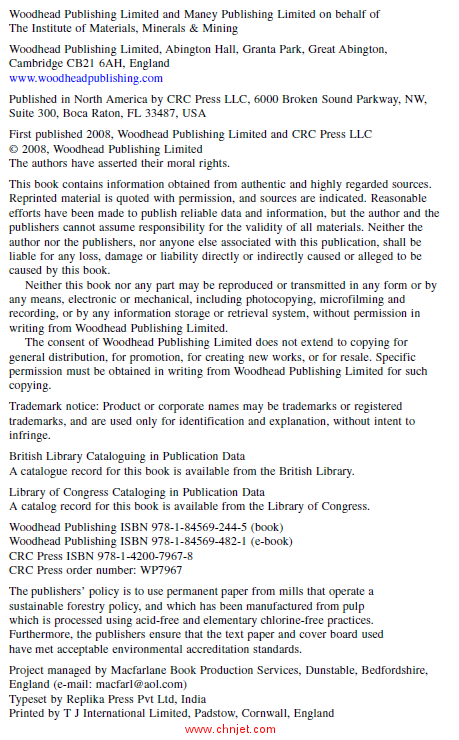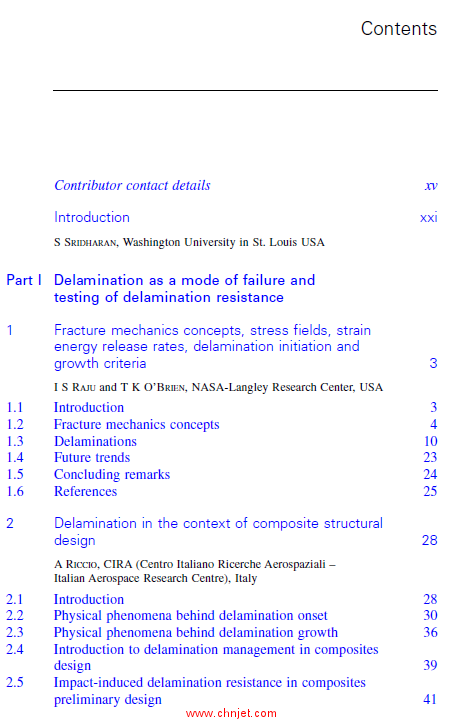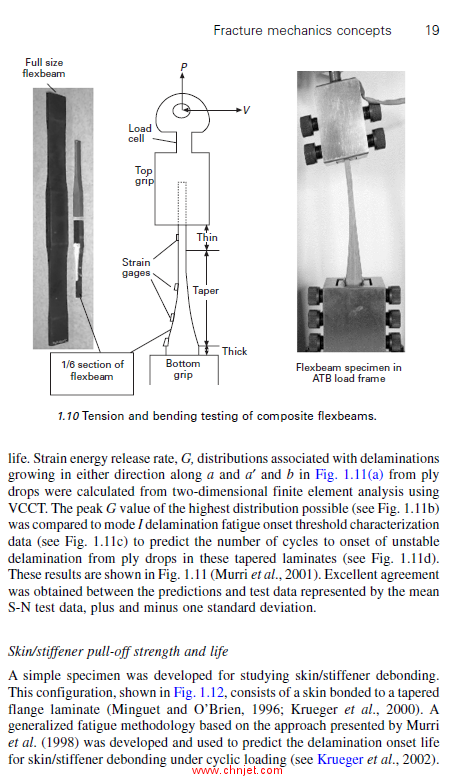马上注册,结交更多好友,享用更多功能,让你轻松玩转社区。
您需要 登录 才可以下载或查看,没有账号?立即注册

×
《Delamination behaviour of composites》
复合材料的分层行为
编辑:Srinivasan Sridharan
出版社:WP
出版时间:2008年
《Delamination behaviour of composites》

《Delamination behaviour of composites》

《Delamination behaviour of composites》

《Delamination behaviour of composites》

目录
Contributor contact details xv
Introduction xxi
S SRIDHARAN, Washington University in St. Louis USA
Part I Delamination as a mode of failure and
testing of delamination resistance
1 Fracture mechanics concepts, stress fields, strain
energy release rates, delamination initiation and
growth criteria 3
I S RAJU and T K O’BRIEN, NASA-Langley Research Center, USA
1.1 Introduction 3
1.2 Fracture mechanics concepts 4
1.3 Delaminations 10
1.4 Future trends 23
1.5 Concluding remarks 24
1.6 References 25
2 Delamination in the context of composite structural
design 28
A RICCIO, CIRA (Centro Italiano Ricerche Aerospaziali –
Italian Aerospace Research Centre), Italy
2.1 Introduction 28
2.2 Physical phenomena behind delamination onset 30
2.3 Physical phenomena behind delamination growth 36
2.4 Introduction to delamination management in composites
design 39
2.5 Impact-induced delamination resistance in composites
preliminary design 41
v
© 2008, Woodhead Publishing Limited
2.6 Delamination tolerance in composites preliminary design 46
2.7 Cost-effective delamination management 55
2.8 References 60
3 Review of standard procedures for delamination
resistance testing 65
P DAVIES, IFREMER Centre de Brest, France
3.1 Introduction 65
3.2 Historical background 66
3.3 Mode I 67
3.4 Mode II 70
3.5 Mode III 74
3.6 Mixed mode I/II 76
3.7 Conclusion on fracture mechanics tests to measure
delamination resistance 79
3.8 Future trends 80
3.9 Conclusion 81
3.10 Sources of information and advice 81
3.11 Acknowledgements 81
3.12 References 81
4 Testing methods for dynamic interlaminar fracture
toughness of polymeric composites 87
C T SUN, Purdue University, USA
4.1 Introduction 87
4.2 Dynamic loading and crack propagation 90
4.3 Mode I loading with double cantilever beam (DCB) for
low crack velocity 93
4.4 High crack velocity with modified double cantilever
beam (DCB) and end notch flexure (ENF) 95
4.5 Mode I by wedge loading with Hopkinson bar 104
4.6 Acknowledgment 115
4.7 References 115
5 Experimental characterization of interlaminar shear
strength 117
R GANESAN, Concordia University, Canada
5.1 Introduction 117
5.2 Short beam shear test 118
5.3 Double-notch shear test 125
5.4 Arcan Test 133
vi Contents
© 2008, Woodhead Publishing Limited
5.5 Conclusion 134
5.6 References 135
5.7 Appendix: Nomenclature 136
Part II Delamination: detection and characterization
6 Integrated and discontinuous piezoelectric
sensor/actuator for delamination detection 141
P TAN, Defence Science and Technology Organisation, Australia
and L TONG, University of Sydney, Australia
6.1 Introduction 141
6.2 Typical patterns for piezoelectric (PZT) or piezoelectric
fiber reinforced composite (PFRC) sensor/actuator 143
6.3 Constitutive equations and modelling development for a
laminated beam with a single delamination and
surface-bonded with an integrated piezoelectric
sensor/actuator (IPSA) 146
6.4 Parametric study 149
6.5 Experimental verification 157
6.6 Conclusions 165
6.7 Acknowledgments 165
6.8 References 165
6.9 Appendix 167
7 Lamb wave-based quantitative identification of
delamination in composite laminates 169
Z SU, The Hong Kong Polytechnic University, Hong Kong and
L YE, The University of Sydney, Australia
7.1 Introduction 169
7.2 Lamb waves in composite laminates 170
7.3 Lamb wave scattering by delamination 177
7.4 Lamb wave-based damage identification for composite
structures 180
7.5 Design of a diagnostic Lamb wave signal 181
7.6 Digital signal processing (DSP) 182
7.7 Signal pre-processing and de-noising 186
7.8 Digital damage fingerprints (DDF) 187
7.9 Data fusion 193
7.10 Sensor network for delamination identification 198
7.11 Case studies: evaluation of delamination in composite
laminates 202
Contents vii
© 2008, Woodhead Publishing Limited
7.12 Conclusion 211
7.13 Acknowledgements 211
7.14 References 212
8 Acoustic emission in delamination investigation 217
J BOHSE, BAM-Federal Institute for Materials Research and Testing,
Germany and A J BRUNNER, Empa-Swiss Federal Laboratories for
Materials Testing and Research, Switzerland
8.1 Introduction 217
8.2 Acoustic emission (AE) analysis 218
8.3 Acoustic emission analysis applied to investigation of
delaminations in fiber-reinforced, polymer-matrix (FRP) 222
8.4 Acoustic emission monitoring of delaminations in
fiber-reinforced, polymer matrix composite specimens 223
8.5 Acoustic emission investigation of delaminations in
structural elements and structures 253
8.6 Advantages and limitations for acoustic emission
delamination investigations 267
8.7 Related nondestructive acoustic methods for delamination
investigations 272
8.8 Summary and outlook 272
8.9 Acknowledgments 273
8.10 References 273
Part III Analysis of delamination behaviour from tests
9 Experimental study of delamination in cross-ply
laminates 281
A J BRUNNER, Empa-Swiss Federal Laboratories for Materials
Testing and Research, Switzerland
9.1 Introduction 281
9.2 Summary of current state 282
9.3 Experimental methods for studying delaminations 285
9.4 Fracture mechanics study of delamination in cross-ply
laminates 286
9.5 Discussion and interpretation 300
9.6 Structural elements or parts with cross-ply laminates 304
9.7 Summary and outlook 305
9.8 Acknowledgments 305
9.9 References 305
viii Contents
© 2008, Woodhead Publishing Limited
10 Interlaminar mode II fracture characterization 310
M F S F DE MOURA, Faculdade de Engenharia da Universidade
do Porto, Portugal
10.1 Introduction 310
10.2 Static mode II fracture characterization 311
10.3 Dynamic mode II fracture characterization 321
10.4 Conclusions 324
10.5 Acknowledgements 324
10.6 References 325
11 Interaction of matrix cracking and delamination 327
M F S F DE MOURA, Faculdade de Engenharia da Universidade do
Porto, Portugal
11.1 Introduction 327
11.2 Mixed-mode cohesive damage model 332
11.3 Continuum damage mechanics 338
11.4 Conclusions 341
11.5 References and further reading 342
12 Experimental studies of compression failure of
sandwich specimens with face/core debond 344
F AVILÉS, Centro de Investigación Científica de Yucatán, A C,
México and L A CARLSSON, Florida Atlantic University, USA
12.1 Introduction 344
12.2 Compression failure mechanism of debonded structures 344
12.3 Compression failure of debonded sandwich columns 346
12.4 Compression failure of debonded sandwich panels 353
12.5 Acknowledgments 362
12.6 References 362
Part IV Modelling delamination
13 Predicting progressive delamination via interface
elements 367
S HALLETT, University of Bristol, UK
13.1 Introduction 367
13.2 Background to the development of interface elements 367
13.3 Numerical formulation of interface elements 368
13.4 Applications 373
13.5 Enhanced formulations 380
Contents ix
© 2008, Woodhead Publishing Limited
13.6 Conclusions 382
13.7 Acknowledgements 382
13.8 References 382
14 Competing cohesive layer models for prediction of
delamination growth 387
S SRIDHARAN, Washington University in St. Louis, USA
and Y LI, Intel Corporation, USA
14.1 Introduction 387
14.2 User material model 388
14.3 User supplied element model 391
14.4 Double cantilever problem 394
14.5 UMAT model: details of the study and discussion of results 394
14.6 UEL model: details of the study and discussion of results 403
14.7 Delamination of composite laminates under impact 407
14.8 Conclusion 427
14.9 References 427
15 Modeling of delamination fracture in composites:
a review 429
R C YU, Universidad de Castilla-La Mancha, Spain and A PANDOLFI,
Politecnico di Milano Italy
15.1 Introduction 429
15.2 The cohesive approach 431
15.3 Delamination failure in fiber reinforced composites 432
15.4 Delamination failure in layered structures 440
15.5 Summary and conclusions 450
15.6 Acknowledgements 451
15.7 References 452
16 Delamination in adhesively bonded joints 458
B R K BLACKMAN, Imperial College London, UK
16.1 Introduction 458
16.2 Adhesive bonding of composites 458
16.3 Fracture of adhesively bonded composite joints 460
16.4 Future trends 479
16.5 Sources of further information and advice 480
16.6 References 481
x Contents
© 2008, Woodhead Publishing Limited
17 Delamination propagation under cyclic loading 485
P P CAMANHO, Universidade do Porto, Portugal and A TURON and
J COSTA, University of Girona, Spain
17.1 Introduction and motivation 485
17.2 Experimental data 486
17.3 Damage mechanics models 488
17.4 Simulation of delamination growth under fatigue loading
using cohesive elements: cohesive zone model approach 490
17.5 Numerical representation of the cohesive zone model 491
17.6 Constitutive model for high-cycle fatigue 493
17.7 Examples 498
17.8 Mode I loading 498
17.9 Mode II loading 502
17.10 Mixed-mode I and II loading 504
17.11 Fatigue delamination on a skin-stiffener structure 505
17.12 Conclusions 510
17.13 Acknowledgments 510
17.14 References and further reading 511
18 Single and multiple delamination in the presence of
nonlinear crack face mechanisms 514
R MASSABÒ, University of Genova, Italy
18.1 Introduction 514
18.2 The cohesive- and bridged-crack models 515
18.3 Characteristic length scales in delamination fracture 528
18.4 Derivation of bridging traction laws 535
18.5 Single and multiple delamination fracture 539
18.6 Final remarks 553
18.7 Acknowledgement 555
18.8 References 555
Part V Analysis of structural performance in the presence
of delamination, and prevention/mitigation of
delamination
19 Determination of delamination damage in
composites under impact loads 561
A F JOHNSON and N TOSO-PENTECÔTE, German Aerospace Centre
(DLR), Germany
19.1 Introduction 561
19.2 Composites failure modelling 563
Contents xi
© 2008, Woodhead Publishing Limited
19.3 Delamination damage in low velocity impact 570
19.4 Delamination damage in high velocity impact 576
19.5 Conclusions and future outlook 583
19.6 References 584
20 Delamination buckling of composite cylindrical
shells 586
A TAFRESHI, The University of Manchester, UK
20.1 Introduction 586
20.2 Finite element analysis 588
20.3 Validation study 597
20.4 Results and discussion: analysis of delaminated
composite cylindrical shells under different types of
loadings 597
20.5 Conclusion 614
20.6 References 616
21 Delamination failure under compression of
composite laminates and sandwich structures 618
S SRIDHARAN, Washington University in St. Louis, USA, Y LI, Intel
Corporation, USA and S EL-SAYED, Caterpillar Inc., USA
21.1 Introduction 618
21.2 Case study (1): composite laminate under longitudinal
compression 619
21.3 Case study (2): dynamic delamination of an axially
compressed sandwich column 628
21.4 Case study (3): two-dimensional delamination of
laminated plates 635
21.5 Results and discussion 644
21.6 Conclusion 647
21.7 References 648
22 Self-healing composites 650
M R KESSLER, Iowa State University, USA
22.1 Introduction 650
22.2 Self-healing concept 652
22.3 Healing-agent development 657
22.4 Application to healing of delamination damage in FRPs 661
22.5 Conclusions 670
22.6 References and further reading 671
xii Contents
© 2008, Woodhead Publishing Limited
23 Z-pin bridging in composite delamination 674
H Y LIU, The University of Sydney, Australia and
W YAN, Monash University, Australia
23.1 Introduction 674
23.2 Z-pin bridging law 675
23.3 Effect of z-pin bridging on composite delamination 677
23.4 Z-pin bridging under high loading rate 693
23.5 Fatigue degradation on z-pin bridging force 699
23.6 Future trends 703
23.7 References 704
24 Delamination suppression at ply drops by ply
chamfering 706
M R WISNOM and B KHAN, University of Bristol, UK
24.1 Introduction 706
24.2 Behaviour of tapered composites with
ply drops 707
24.3 Methods of chamfering plies 711
24.4 Results of ply chamfering 713
24.5 Summary and conclusions 719
24.6 References 720
25 Influence of resin on delamination 721
S MALL, Air Force Institute of Technology, USA
25.1 Introduction 721
25.2 Resin toughness versus composite toughness 722
25.3 Resin toughness effects on different modes 725
25.4 Resin effects on cyclic delamination behaviour 729
25.5 Temperature considerations 733
25.6 Effects of interleafing and other methods 735
25.7 Summary 737
25.8 References 739
专业书籍
下载地址:(回复后可见)
|
![]()